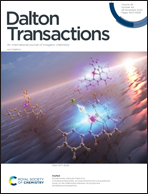CFA-18: a homochiral metal–organic framework (MOF) constructed from rigid enantiopure bistriazolate linker molecules†
Abstract
In this work, we introduce the first enantiopure bistriazolate-based metal–organic framework, CFA-18 (Coordination Framework Augsburg-18), built from the R-enantiomer of 7,7,7′,7′-tetramethyl-6,6′,7,7′-tetrahydro-3H,3′H-5,5′-spirobi[indeno[5,6-d]-[1,2,3]triazole] (H2-spirta). The enantiopurity and absolute configuration of the new linker were confirmed by several chiroselective methods. Reacting H2-spirta in hot N,N-dimethylformamide (DMF) with manganese(II) chloride gave CFA-18 as colorless crystals. The crystal structure with the composition [Mn2Cl2(spirta)(DMF)2] was solved using synchrotron single-crystal X-ray diffraction. CFA-18 shows a framework topology that is closely related to previously reported metal–azolate framework (MAF) structures in which the octahedrally coordinated manganese(II) ions are triazolate moieties, and the chloride anions form crosslinked one-dimensional helical chains, giving rise to hexagonal channels. In contrast to MAFs crystallizing in the centrosymmetric space group R![[3 with combining macron]](https://www.rsc.org/images/entities/char_0033_0304.gif) , the handedness of the helices found in CFA-18 is strictly uniform, leading to a homochiral framework that crystallizes in the trigonal crystal system within the chiral space group P3121 (no. 152).
, the handedness of the helices found in CFA-18 is strictly uniform, leading to a homochiral framework that crystallizes in the trigonal crystal system within the chiral space group P3121 (no. 152).



 Please wait while we load your content...
Please wait while we load your content...